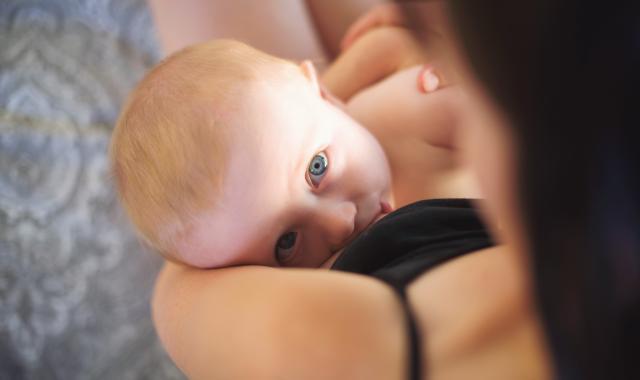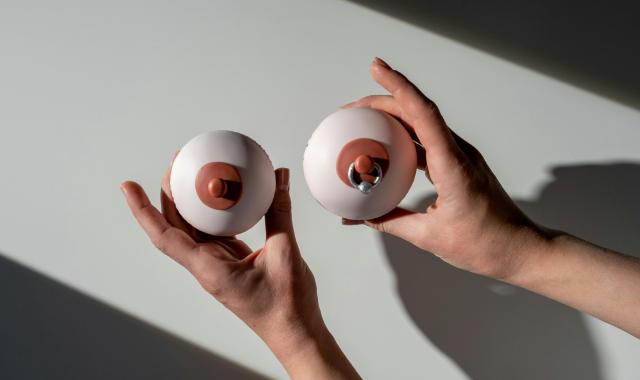Pierced nipples in your past, present or future?
There’s a good chance you can still breastfeed.

If you're thinking about (or already have) pierced nipples, you may wonder how it could affect the way you feed your baby.
It can be hard to find good information on this, because there isn’t much research on how nipple piercings affect making breastmilk and breastfeeding. But if your piercings have healed well (this can take a year or more), there’s no reason to think you won’t be able to breastfeed.
There are a few options for how you can do this, so here are some things to think about...
Comfort and convenience
Women with pierced nipples often remove their jewellery during pregnancy because their nipples feel too sensitive. Metal jewellery may also begin to feel uncomfortable as the breasts change shape and size. Flexible silicone jewellery may be a more comfortable option.
Many women choose to leave their jewellery out for the duration of breastfeeding to avoid any extra hassle. The piercing tracts often close up quickly, but can be pierced again later if you choose. If you don’t want them to close, you may be able to use temporary plastic retainers to keep the holes open.
Some women remove and replace the jewellery for each breastfeed, but this can be tricky. Young babies breastfeed often (around 8 to14 times a day) and can get upset if they have to wait for a breastfeed, even if only for a few minutes.
If you take your jewellery off before a feed and plan to replace it, remember to put it back in immediately. The healing properties of breastmilk can cause the hole to close up quickly.
Safety
It’s recommended that you remove your nipple jewellery before breastfeeding for a few reasons:
-
A baby may find it hard to feed from a breast with jewellery in place. They may slurp, gag or come on and off the breast. This can make breastfeeds feel stressful for both mum and baby. Milk may also leak from the baby’s mouth and their sucking may not remove milk from the breast very well. In time, this can cause the breast to make less milk. These problems usually resolve if the nipple jewellery is removed.
-
Jewellery could harm the baby's mouth. The jewellery is usually wider than the nipple itself to allow for swelling after piercing. The baby's lips, gums, tongue or palate could be hurt.
-
There’s a risk the baby could breathe in, swallow or choke on jewellery. As your baby sucks, the nipple changes shape. The piercing hole may stretch and cause your jewellery to come loose. If you do try to breastfeed with your jewellery in place, check it’s secure before you begin.
Breastmilk supply
Nipple piercings may lead to low milk supply if they affect how well the breastmilk is removed from the pierced breast(s). This can happen if the piercing damaged one or more milk ducts or nerves, even if it was a long time ago.
The milk ducts are narrow tubes that carry milk from deep in the breast (where it is made) to the nipple. If the ducts are damaged, the milk may not flow easily. Multiple piercings, severe infections or other past problems with piercings may increase the risk of damage and scarring. This makes breastfeeding problems more likely.
If only one nipple is pierced, or only one breast has low supply, the other breast may produce more milk to make up for it. It’s possible to feed a baby from only one breast, if needed. Some women choose to pierce only one nipple for this reason, keeping one breast unaltered for future breastfeeding.

There’s no way to know if your milk flow has been affected until you begin to breastfeed. Keep in mind that many women with pierced nipples have no problems. Feeding your baby often from birth will give you the best chance of building up a healthy supply.
Your questions answered
Some mums see milk leaking from the piercing holes when their milk begins to flow at the start of each feed (known as the let-down reflex). You probably won’t notice this when you breastfeed, because your baby’s mouth will cover the holes.
If your baby has a good mouthful of nipple, any milk that does leak from the holes will flow into their mouth and is unlikely to be a problem. Absorbent breast pads can be placed in your bra to help with leaking milk between feeds.
Possibly. Using a breast pump may be difficult because the jewellery is likely to be wider than the tunnel of the plastic shield that sits over the nipple. Expressing your milk by hand may be an easier and more comfortable option.
If you plan to remove your nipple jewellery for each feed, replace them immediately afterwards so the holes don’t close up.
Practice good hygiene to avoid infection. It may help to keep hand sanitiser and a clean container to store your jewellery in close to where you breastfeed. Try to get into the habit of washing your hands and jewellery at each feed to keep everything clean.
The risks that apply to body piercing in general (eg infection) also apply to nipple piercing. You can contact your local health department to ask about laws and regulations to do with the safety and hygiene of nipple piercing.
In rare cases, even women who aren’t breastfeeding begin to produce milk and can develop breast health problems such as mastitis and/or abscess following nipple piercing. The risk of infection in the breast is highest with a recent nipple piercing. Visit your doctor if you notice breast pain, fluid leaking from the nipple or any signs of infection following nipple piercing (even if your piercing was done some time ago).
If you remove your jewellery for the full duration of breastfeeding, the holes are likely to close. This can happen even if they had been pierced for a long time. It’s a good idea to wait a few months after weaning before you have them re-pierced. This is because the breasts continue to make some milk for many months. Waiting until your breasts are no longer making milk and have returned to their normal size and shape will help to prevent any problems.
If you think you may have another baby and breastfeed again, you may want to wait longer. Having the nipples re-pierced multiple times could increase the risk of damage and breastfeeding problems. Piercings that are still healing may not heal well if you begin breastfeeding another baby. The breastmilk could cause the holes to close completely, or breast changes and stretching during feeds could prevent them healing at all.
Talk to your doctor as well as a professional body piercer to help you decide. Even if you aren’t breastfeeding, most professional body piercers will suggest you wait at least 6 weeks after your baby is born before you have any body piercing.
If you've had a nipple pierced and are having problems breastfeeding, speak to an ABA breastfeeding counsellor, doctor or lactation consultant for help. Make sure to mention your piercings, even if the holes have now closed.
With good information and support, there is every chance you'll be able to breastfeed your baby.
© Australian Breastfeeding Association March 2024
- Garbin, C. P., Deacon, J. P., Rowan, M. K., Hartmann, P. E., & Geddes, D. T. (2009). Association of nipple piercing with abnormal milk production and breastfeeding. JAMA, 301(24), 2550–2551. https://doi.org/10.1001/jama.2009.877
- Holbrook, J., Minocha, J., & Laumann, A. (2012). Body piercing: complications and prevention of health risks. American Journal of Clinical Dermatology, 13(1), 1–17. https://doi.org/10.2165/11593220-000000000-00000
- Martin, J. (2004). Is nipple piercing compatible with breastfeeding? Journal of Human Lactation, 20(3), 319–321. https://doi.org/10.1177/0890334404266876
- Nipple Piercing. (2021). In Drugs and Lactation Database (LactMed®). National Institute of Child Health and Human Development. https://www.ncbi.nlm.nih.gov/books/NBK500564/
- Rademeyer, C., Farley, C. L., & Van Hoover, C. (2020). Health implications and counseling considerations for individuals with piercings and tattoos. Nursing for Women's Health, 24(3), 210–227. https://doi.org/10.1016/j.nwh.2020.03.006
- Roche-Paull R. (2015). Body modifications and breastfeeding: What you need to know. Journal of Human Lactation, 31(3), 552–553. https://doi.org/10.1177/0890334415584597
-
Van Hoover, C., Rademayer, C. A., & Farley, C. L. (2017). Body piercing: Motivations and implications for health. Journal of Midwifery & Women's Health, 62(5), 521–530. https://doi.org/10.1111/jmwh.12630
